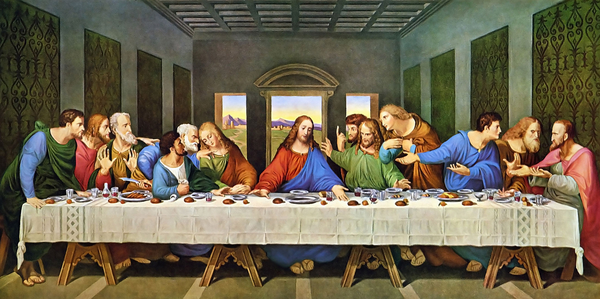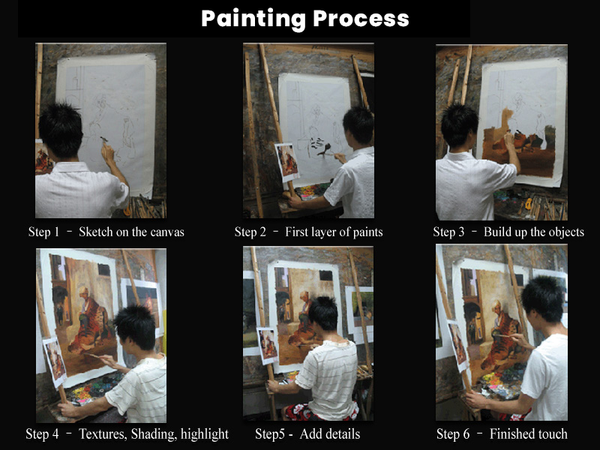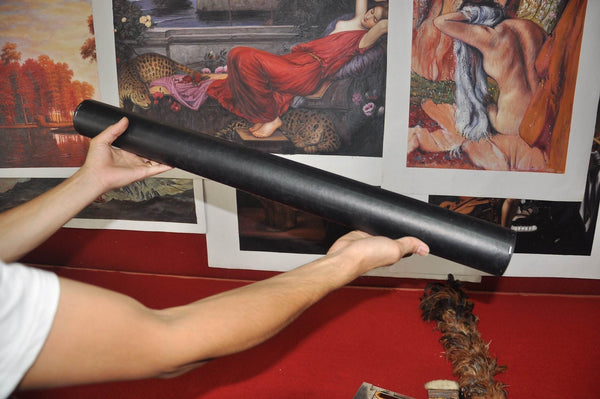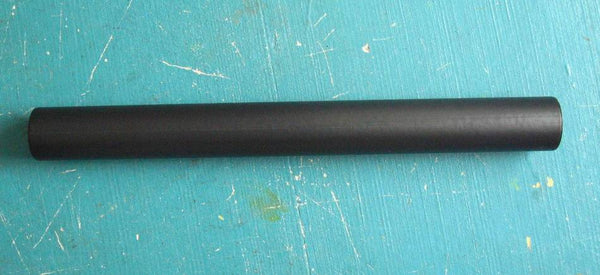The Last Supper, Oil painting Replica | Leonardo da Vinci | 1495 | Small 40" X 20"
*This items will be shipped only Oil Painting Canvas rolled in a safe round Mail Tube.
Please noted it is not coming with frame.
** Item will be delivered to your shipping address in 3 weeks since hand-painted ordered item needs to complete 2 weeks. Please be advised this turnaround time!!
da Vinci's Masterpiece which reproduced with oil painting on high-quality canvas.
An experienced artist has invested more than two weeks of time to recreate this artwork by Leonardo da Vinci that will adorn your home or office.
After your order is finished by the hand oil painting, it is wrapped in a film to prevent damage to the painting and placed in a round mail tube. We ship this tube to you. So, you will receive a hand-painted piece that is unlikely to be damaged, and the work of art that is nearly identical to the original becomes yours. After that, you go to a nearby picture frame shop, make a picture frame that matches the atmosphere of the interior and hang it on the wall, and you will have a work that can be passed down from generation to generation.
Background : One of the most famous paintings in the world, The Last Supper by Leonardo da Vinci was painted in the late 15th century for the Dominican monastery Santa Maria delle Grazie in Milan. The wall painting was commissioned by the Duke of Milan, Ludovico Sforza, who was Leonardo’s patron during his first extended stay in Milan.
The composition of The Last Supper is neatly arranged - Jesus is positioned in the center of a long table and the Apostles are to his left and right. The room is relatively plain: dark tapestries cover the walls on either side, while three windows on the back wall reveal a landscape that recalls the countryside of Milan. Leonardo created the illusion of space by using linear perspective – a technique in which all parallel lines in the painting converge in a single vanishing point. In The Last Supper, the single vanishing point, at Jesus’s right temple, draws the viewer’s attention to the main subject in the foreground. Jesus adorns the traditional blue and red robes, but he has no halo. Some scholars have suggested that Leonardo alludes to the halo through the shining light from the window behind Jesus, or the pediment above the window. Others however believed that the absence of the halo signifies the fact that Jesus is a still human being, who, as such, will suffer through the pain and death of the Passion.
In his depiction of The Last Supper, Leonardo chose to present the scene as a depiction of successive moments: Jesus has declared to the Apostles that one of them will betray him, and the Apostles react to his announcement. The serene expression and posture of Christ stands in contrast to the confused and agitated state of the Apostles. Their reactions and postures vary, adding interest and drama to the composition: on Christ’s left, James the Greater throws his arms out in anger, Thomas gestures to the sky as if to question God’s plan, and Phillip points towards himself wondering could he be the traitor. Some reactions hold additional symbolism: Peter holds a knife behind his back that he will later use to cut off an ear of a soldier attempting to arrest Christ. Judas, who is next to Peter, tightly grips the purse with the reward he received for betraying Jesus with one hand, while he reaches toward a dish with the other. Judas and Jesus reach for the same dish, a reference to the biblical quote: “The one who has dipped his hand into the bowl with me will betray me” (Matthew 26:23).
When painting The Last Supper Leonardo used an experimental technique, working with tempera and oil paint. The experimental technique combined with the humidity and the dampness of the location led to the quick deterioration of the painting. Over the centuries, the painting suffered additional damage. Due to its poor condition, the painting underwent a major restoration that began in 1978. The restoration, completed in 1999, proved controversial: many were dissatisfied with the outcome saying that hardly any of Leonardo’s original work is visible. Still, some praised the recovery of many details, like the food on the table and the facial expressions.
Leonardo da Vinci :(15 April 1452 – 2 May 1519) was an Italian polymath of the High Renaissance who was active as a painter, draughtsman, engineer, scientist, theorist, sculptor, and architect.[3] While his fame initially rested on his achievements as a painter, he also became known for his notebooks, in which he made drawings and notes on a variety of subjects, including anatomy, astronomy, botany, cartography, painting, and paleontology. Leonardo's genius epitomized the Renaissance humanist ideal,[4] and his collective works compose a contribution to later generations of artists matched only by that of his younger contemporary, Michelangelo.[3][4]
Born out of wedlock to a successful notary and a lower-class woman in, or near, Vinci, he was educated in Florence by the Italian painter and sculptor Andrea del Verrocchio. He began his career in the city, but then spent much time in the service of Ludovico Sforza in Milan. Later, he worked in Florence and Milan again, as well as briefly in Rome, all while attracting a large following of imitators and students. Upon the invitation of Francis I, he spent his last three years in France, where he died in 1519. Since his death, there has not been a time where his achievements, diverse interests, personal life, and empirical thinking have failed to incite interest and admiration,[3][4] making him a frequent namesake and subject in culture.
Leonardo is among the greatest painters in the history of art and is often credited as the founder of the High Renaissance.[3] Despite having many lost works and less than 25 attributed major works—including numerous unfinished works—he created some of the most influential paintings in Western art.[3] His magnum opus, the Mona Lisa, is his best known work and often regarded as the world's most famous painting. The Last Supper is the most reproduced religious painting of all time and his Vitruvian Man drawing is also regarded as a cultural icon. In 2017, Salvator Mundi, attributed in whole or part to Leonardo,[5] was sold at auction for US$450.3 million, setting a new record for the most expensive painting ever sold at public auction.
Revered for his technological ingenuity, he conceptualized flying machines, a type of armored fighting vehicle, concentrated solar power, an adding machine,[6] and the double hull. Relatively few of his designs were constructed or even feasible during his lifetime, as the modern scientific approaches to metallurgy and engineering were only in their infancy during the Renaissance. Some of his smaller inventions, however, entered the world of manufacturing unheralded, such as an automated bobbin winder and a machine for testing the tensile strength of wire. He made substantial discoveries in anatomy, civil engineering, hydrodynamics, geology, optics, and tribology, but he did not publish his findings and they had little to no direct influence on subsequent science.
*All drawings drawn from the original paintings are hand-drawn by the reproduction artist on canvas. Therefore, it cannot be 100% equivalent to the original artwork. If you want a 100% identical picture, it is correct to look for the one printed on the printer, not the one drawn. Please be mindful of this and make sure there are no mistakes in your order.









